| #10 - The Slow Loris |
| The Top Eleven Weirdest Mammals - Part I |
| Written by Jonathan C. Wojcik - Photo credits unknown or from public news articles unless otherwise noted. If you know their sources and need them credited or removed, please e-mail me. |
They don't have barbed pincers, stinging cells or suckered tentacles. They don't exhibit
bioluminescence, endoparasitism or metamorphosis, they have no more or less than
four appendages and only a few of them are venomous. As mammals ourselves, we like
to think of this small and fairly recent group as the "norm" by which all other organisms
are judged; we gauge the "weirdness" of another animal almost strictly by how far
removed it is from one of our fellow mammals, even when insects and mollusks have
roamed the planet longer and in far greater numbers.
Mammals aren't something that will come up all that often here, but within this supposedly
"conventional" little group are plenty of oddball surprises...
bioluminescence, endoparasitism or metamorphosis, they have no more or less than
four appendages and only a few of them are venomous. As mammals ourselves, we like
to think of this small and fairly recent group as the "norm" by which all other organisms
are judged; we gauge the "weirdness" of another animal almost strictly by how far
removed it is from one of our fellow mammals, even when insects and mollusks have
roamed the planet longer and in far greater numbers.
Mammals aren't something that will come up all that often here, but within this supposedly
"conventional" little group are plenty of oddball surprises...
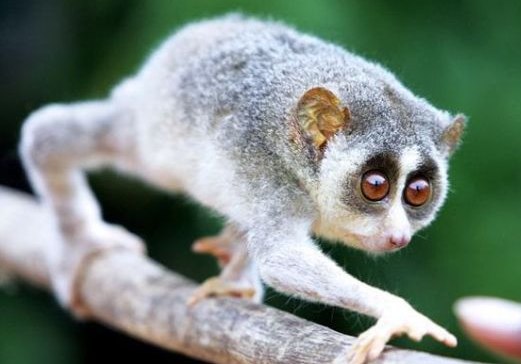
Three species comprise the genus Nycticebus of the family Lorisidae, a primitive branch
of primates like the lemurs. Arboreal and slow-moving though not nearly so much as the
sloths (later,) they are egg eaters and predators feeding on snails, arthropods, reptiles
and any other small creatures they can catch. Uniquely among primates and rare for
Mammalia in general, they are actually toxic, secreting poison from glands on the inside
of their elbows. They regularly lick this substance onto their teeth, arming themselves with
a venomous bite that can cause significant pain and swelling. They may also smear the
poison onto the fur of their young, making them distasteful to larger predators.
of primates like the lemurs. Arboreal and slow-moving though not nearly so much as the
sloths (later,) they are egg eaters and predators feeding on snails, arthropods, reptiles
and any other small creatures they can catch. Uniquely among primates and rare for
Mammalia in general, they are actually toxic, secreting poison from glands on the inside
of their elbows. They regularly lick this substance onto their teeth, arming themselves with
a venomous bite that can cause significant pain and swelling. They may also smear the
poison onto the fur of their young, making them distasteful to larger predators.
| #9 - Pink Fairy Armadillo |
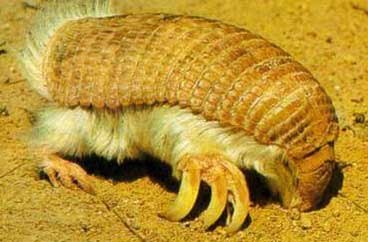
Given a reptilian appearance by their leathery, armored hides, the armadillos or family
Dasypodidae are an ancient and highly adaptable group of insect-eaters that thrive in a
wide range of warm environments. All armadillos are skilled burrowers, but
Chlamyphorus truncatus, the pink fairy armadillo, has adapted to a largely subterranean
existence, with shovel-like claws and greatly reduced eyes. Perhaps most unusual is the
cork-like rump that plugs its own burrow, an armored surface too sheer for most
predators to get a grip on.
Dasypodidae are an ancient and highly adaptable group of insect-eaters that thrive in a
wide range of warm environments. All armadillos are skilled burrowers, but
Chlamyphorus truncatus, the pink fairy armadillo, has adapted to a largely subterranean
existence, with shovel-like claws and greatly reduced eyes. Perhaps most unusual is the
cork-like rump that plugs its own burrow, an armored surface too sheer for most
predators to get a grip on.

| #8 - Wrinkle Faced Bat |

The intricate facial folds of many bats are an adaptation that aids in the echolocation of
flying insects, but as a fruit-eating species, it is not known what Centurio senex does
with the grotesquely rugose skin of its hairless face. What's more, males possess a
fleshy throat-flap that can be pulled over the face like a mask, complete with a pair of
translucent windows over the eyes. It is usually assumed that this retractable "hood" is
associated with courtship, since it is not present in females..
flying insects, but as a fruit-eating species, it is not known what Centurio senex does
with the grotesquely rugose skin of its hairless face. What's more, males possess a
fleshy throat-flap that can be pulled over the face like a mask, complete with a pair of
translucent windows over the eyes. It is usually assumed that this retractable "hood" is
associated with courtship, since it is not present in females..

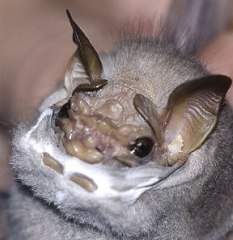
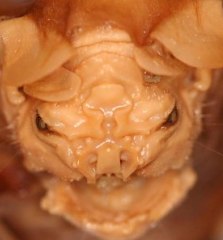
| #7 - The Narwhal |
The arctic-dwelling Monodon monocerous ("one horn, one tooth") or "Narwhal" is
named for the single, unicorn-like "horn" of the male, actually the left incisor. The tooth
begins to poke through the upper lip as the animal reaches maturity, and spirals
clockwise into a straight spine that can grow to nearly eight feet in length. The purpose of
this tusk was once widely debated and commonly considered a mating display, but more
recent research reveals a thin membrane over its entire surface, densely packed with
nerves that measure every property of the surrounding water, including temperature,
density and even salinity. Interestingly enough, it was a researcher of dental medicine,
Martin Nweeia, who finally discovered this function.
Though rare, it is not unheard of for females to possess "horns" of their own, and roughly
one in 500 Narwhal develop both incisors into tusks. Their common name is derived
from the Norse nar, or "corpse," in reference to their pale and splotchy hide.
named for the single, unicorn-like "horn" of the male, actually the left incisor. The tooth
begins to poke through the upper lip as the animal reaches maturity, and spirals
clockwise into a straight spine that can grow to nearly eight feet in length. The purpose of
this tusk was once widely debated and commonly considered a mating display, but more
recent research reveals a thin membrane over its entire surface, densely packed with
nerves that measure every property of the surrounding water, including temperature,
density and even salinity. Interestingly enough, it was a researcher of dental medicine,
Martin Nweeia, who finally discovered this function.
Though rare, it is not unheard of for females to possess "horns" of their own, and roughly
one in 500 Narwhal develop both incisors into tusks. Their common name is derived
from the Norse nar, or "corpse," in reference to their pale and splotchy hide.
Whales and porpoises are strange enough as it is, with a body plan closer to a fish than
a mammal, they lack all ability to function on land and spend the entirety of their lives in
the water, where they rely on highly advanced echolocation to communicate and hunt.
a mammal, they lack all ability to function on land and spend the entirety of their lives in
the water, where they rely on highly advanced echolocation to communicate and hunt.
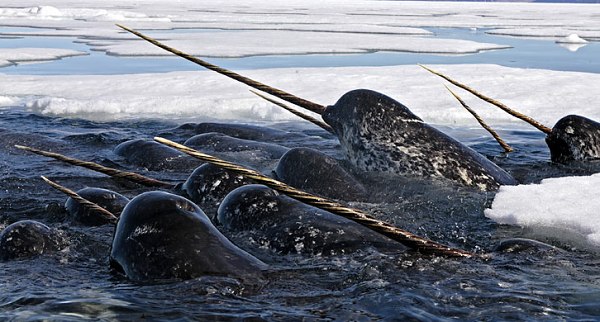
| photo by Paul Nicklen |
| #7 - The Marsupial Mole |

As marsupials native to Australia, the genus Notoryctes are completely unrelated to the
moles of other continents, but follow a strikingly similar body plan and lifestyle. This is
what scientists refer to as convergent species, the idea that certain forms are so simple
and effective that they can independently occur multiple times in nature under similar
enough environmental conditions, the same reason birds and bats have a similar wing
structure or dolphins and sharks have a similar overall shape.
moles of other continents, but follow a strikingly similar body plan and lifestyle. This is
what scientists refer to as convergent species, the idea that certain forms are so simple
and effective that they can independently occur multiple times in nature under similar
enough environmental conditions, the same reason birds and bats have a similar wing
structure or dolphins and sharks have a similar overall shape.
Adapted to "swim" through loose sand, these marsupials have a backwards-facing
pouch, vestigial eyes buried under skin and fur, simple reptilian "pits" for ears and a
leathery shield that covers the muzzle. They prey on any other creature they can catch in
their large claws, tracking the vibrations of prey and tunneling up from below.
pouch, vestigial eyes buried under skin and fur, simple reptilian "pits" for ears and a
leathery shield that covers the muzzle. They prey on any other creature they can catch in
their large claws, tracking the vibrations of prey and tunneling up from below.